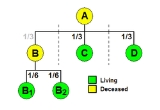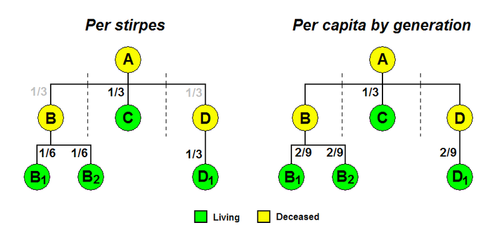
Per stirpes
Encyclopedia
Per stirpes is a legal term in Latin. An estate
of a decedent is distributed per stirpes, if each branch of the family is to receive an equal share of an estate
. When the heir in the first generation of a branch predeceased the decedent, the share that would have been given to the heir would be distributed among the heir's issues in equal shares. It may also be known as right of representation distribution, and differs from distribution per capita as members of the same generation may inherit different amounts.
 Example 1A: The testator
Example 1A: The testator
A, specifies in his will
that his estate is to be divided among his descendants living at his death in equal shares per stirpes. A has three children, B, C, and D. B is already dead, but has left two children (grandchildren of A), B1 and B2. When A's will is executed, under a distribution per stirpes, C and D each receive one-third of the estate, and B1 and B2 each receive one-sixth. B1 and B2 constitute one "branch" of the family, and collectively receive a share equal to the shares received by C and D as branches (figure 1).
Example 1B: If grandchild B1 had predeceased A, leaving two children B1a and B1b, and grandchild B2 had also died leaving three children B2a, B2b and B2c, then distribution per stirpes would give one-third each to C and D, one-twelfth each to B1a and B1b, who would constitute a branch, and one-eighteenth each to B2a, B2b and B2c. Thus, the B, C, and D branches receive equal shares of the whole estate, the B1 and B2 branches receive equal shares of the B branch's share, B1a and B1b receive equal shares of the B1 branch's share, and B2a, B2b and B2c receive equal shares of the B2 branch's share.
Example 2A: In the first example, children C and D survive, so the estate is divided at their generation. There were three children, so each surviving child receives one-third. The remainder - B's share - is then divided in the same manner among B's surviving descendants. The result is the same as under per stirpes because B's one-third is distributed to B1 and B2 (one-sixth to each).
 Example 2A: The per capita and per stirpes results would differ if D also pre-deceased with one child, D1 (figure 2). Under per stirpes, B1 and B2 would each receive one-sixth (half of B
Example 2A: The per capita and per stirpes results would differ if D also pre-deceased with one child, D1 (figure 2). Under per stirpes, B1 and B2 would each receive one-sixth (half of B's one-third share), and D1 would receive one-third (all of D's one-third share). Under per capita, the two-thirds remaining after C's one-third share was taken would be divided equally among all three children of B and D. Each would receive two-ninths: B1, B2, and D1 would all receive two-ninths.
Notes:
, a statute modified this definition. Under New York law, the number of branches is determined by reference to the generation nearest the testator which has a surviving descendant. Thus, in the first example, if C and D also are already dead, and each left one child, named (respectively and appropriately) C1 and D1, then each of B1, B2, C1 and D1 would receive one quarter of the estate. This method is actually applied by the states of Alaska, Arizona, Colorado, Hawaii, Maine, Michigan, New Jersey, New Mexico, New York, North Carolina, Oklahoma, Utah, and West Virginia.
Texas also uses this 'modified' version of per stirpes distribution. Although the caption of Texas Probate Code §43 contains the phrase 'per stirpes,' the distribution method described is actually what is known as "per capita with representation." The distribution method for New York (based on the description above) would also be called "per capita with representation."
Estate (law)
An estate is the net worth of a person at any point in time. It is the sum of a person's assets - legal rights, interests and entitlements to property of any kind - less all liabilities at that time. The issue is of special legal significance on a question of bankruptcy and death of the person...
of a decedent is distributed per stirpes, if each branch of the family is to receive an equal share of an estate
Estate (law)
An estate is the net worth of a person at any point in time. It is the sum of a person's assets - legal rights, interests and entitlements to property of any kind - less all liabilities at that time. The issue is of special legal significance on a question of bankruptcy and death of the person...
. When the heir in the first generation of a branch predeceased the decedent, the share that would have been given to the heir would be distributed among the heir's issues in equal shares. It may also be known as right of representation distribution, and differs from distribution per capita as members of the same generation may inherit different amounts.
Examples

Testator
A testator is a person who has written and executed a last will and testament that is in effect at the time of his/her death. It is any "person who makes a will."-Related terms:...
A, specifies in his will
Will (law)
A will or testament is a legal declaration by which a person, the testator, names one or more persons to manage his/her estate and provides for the transfer of his/her property at death...
that his estate is to be divided among his descendants living at his death in equal shares per stirpes. A has three children, B, C, and D. B is already dead, but has left two children (grandchildren of A), B1 and B2. When A
Example 1B: If grandchild B1 had predeceased A, leaving two children B1a and B1b, and grandchild B2 had also died leaving three children B2a, B2b and B2c, then distribution per stirpes would give one-third each to C and D, one-twelfth each to B1a and B1b, who would constitute a branch, and one-eighteenth each to B2a, B2b and B2c. Thus, the B, C, and D branches receive equal shares of the whole estate, the B1 and B2 branches receive equal shares of the B branch's share, B1a and B1b receive equal shares of the B1 branch's share, and B2a, B2b and B2c receive equal shares of the B2 branch's share.
Per capita at each generation
Per capita at each generation is an alternative way of distribution, where heirs of the same generation will each receive the same amount. The estate is divided into equal shares at the generation closest to the deceased with surviving heirs. The number of shares is equal to the number of original members either surviving or with surviving descendants. Each surviving heir of that generation gets a share. The remainder is then equally divided among the next-generation descendants of the deceased descendants in the same manner.Example 2A: In the first example, children C and D survive, so the estate is divided at their generation. There were three children, so each surviving child receives one-third. The remainder - B

Notes:
- To give the effect indicated in these examples the clause should also include a provision that no beneficiary being a grandchild or remoter descendant will take a share if his or her parent is alive and takes a share.
- The spouses of the children (that is, spouses of B, C, and D) are not considered. Spouses are not a part of the branch. Therefore, even if B, C, or D died leaving a spouse as well as children, all (100%) of the assets pass to the children and (0%) nothing passes to the spouses of A
's children B, C, and D. From the example above, if A's child B died before A's death, A's grandchildren B1 and B2 would each receive half of B's share. Even if B had a living spouse at the time of A's death, that person would receive nothing from A's estate.
Modifications
At least in one state, New YorkNew York
New York is a state in the Northeastern region of the United States. It is the nation's third most populous state. New York is bordered by New Jersey and Pennsylvania to the south, and by Connecticut, Massachusetts and Vermont to the east...
, a statute modified this definition. Under New York law, the number of branches is determined by reference to the generation nearest the testator which has a surviving descendant. Thus, in the first example, if C and D also are already dead, and each left one child, named (respectively and appropriately) C1 and D1, then each of B1, B2, C1 and D1 would receive one quarter of the estate. This method is actually applied by the states of Alaska, Arizona, Colorado, Hawaii, Maine, Michigan, New Jersey, New Mexico, New York, North Carolina, Oklahoma, Utah, and West Virginia.
Texas also uses this 'modified' version of per stirpes distribution. Although the caption of Texas Probate Code §43 contains the phrase 'per stirpes,' the distribution method described is actually what is known as "per capita with representation." The distribution method for New York (based on the description above) would also be called "per capita with representation."

